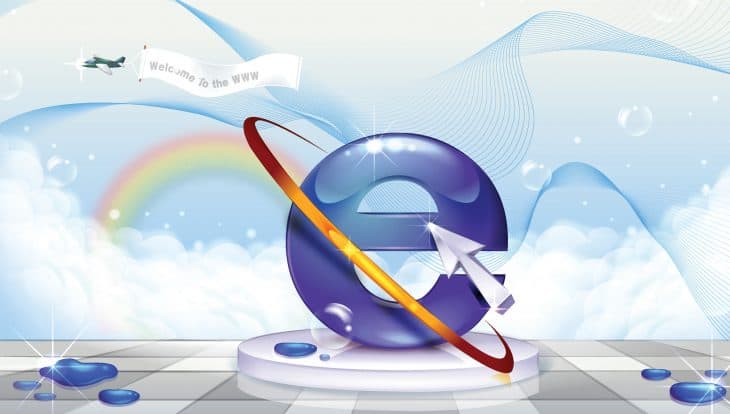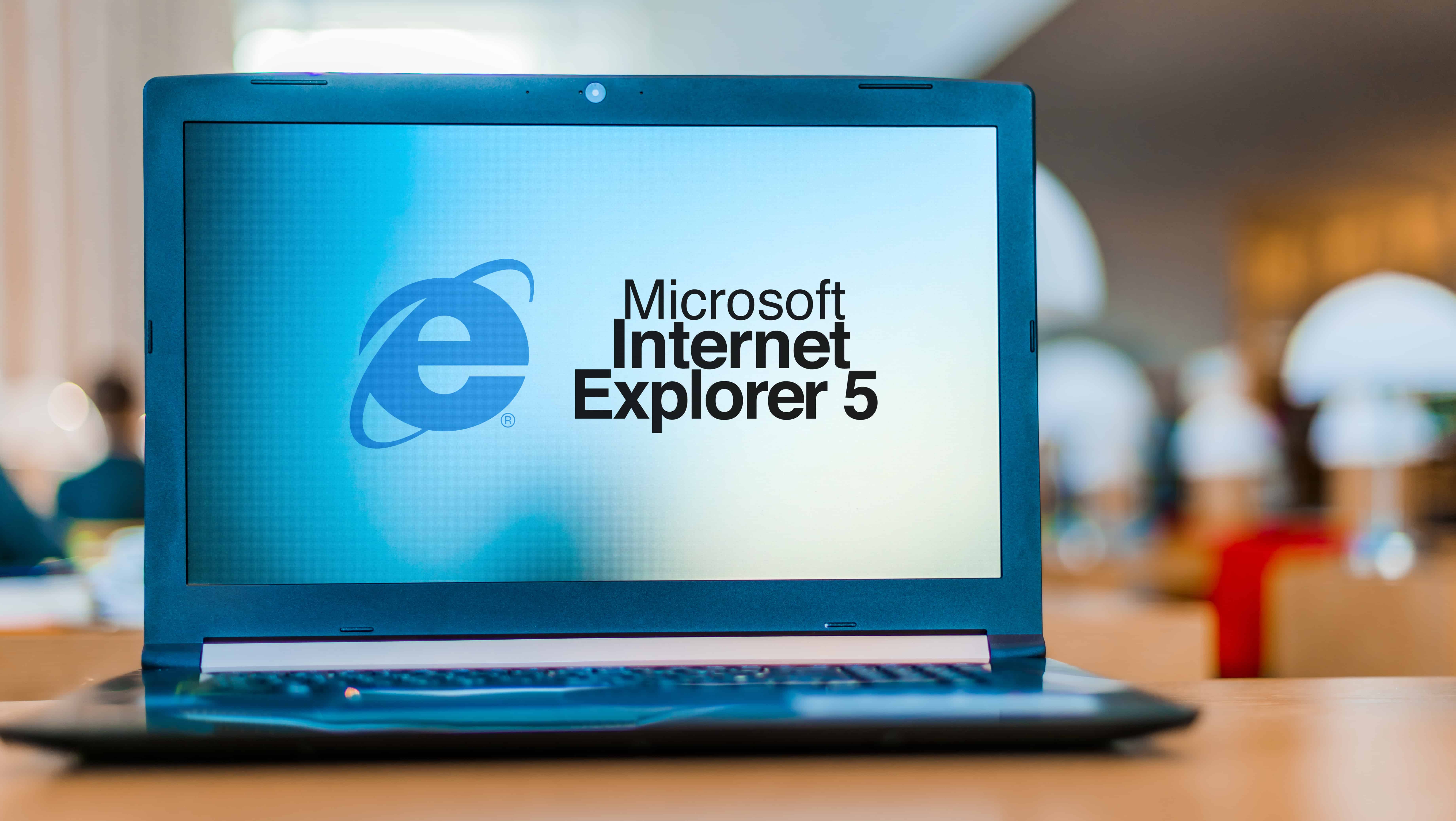
The vast cyberspace we know today came from humble beginnings. And one of the early pioneers of web-surfing is the Microsoft Internet Explorer. Although other web browsers currently dominate the scene, the history of Internet Explorer remains to be worth exploring. With the browser now reaching the end of its life, it’s great to look back with these interesting Internet Explorer facts.
- Internet Explorer (IE) was formerly known as Microsoft Internet Explorer (MSIE).
- It was first released in 1995.
- Internet Explorer was part of the Microsoft Plus! package for Windows 95.
- Microsoft Windows Operating Systems includes the browser.
- Internet Explorer 7 had the codename “Rincon”.
- Early versions used source codes from Spyglass Mosaic.
- Spyglass Mosaic had ties with the NCSA Mosaic but used the NCSA source codes sparingly.
- Internet Explorer 11 is the default browser in the Windows 8.1 update.
- Several months after the release of Internet Explorer 1.0, Microsoft released Version 1.5 for Windows NT.
- Internet Explorer 1.5 offered basic table rendering support, which was a significant web standard at the time.
- Version 2.0 offered support for cookies, SSL, and Internet newsgroups.
- In 1996, Microsoft first made Internet Explorer available for Apple Macintosh devices.
- The last update for Internet Explorer for UNIX was released in 2001.
- As of July 2020, Internet Explorer had a browser market share of about 1.28% worldwide.
- Support for Internet Explorer 10 ended in January 2020.
- Internet Explorer had 11 versions released from 1995 to 2003.
- Its main competitor during the late 1990s was Netscape Navigator.
- Upon its release, Windows 95 had Internet Explorer 3 integrated into the OS.
- It was the default browser for Microsoft Windows prior to 2015.
- Internet Explorer was the default browser for Macintosh from 1998 to 2003.
Internet Explorer Facts Infographics

It all started with a small team.
The original Internet Explorer team consisted of just around five or six individuals working on the project. Thomas Reardon started the project in the summer of 1994. The team grew to around a hundred individuals by 1996 and expanded significantly with more than 1,000 people involved by 1999.
Internet Explorer 1 had the codename “O’Hare”.
Microsoft used codenames for products in development. These codenames are given before they reveal the actual product names that are known to the public. The codename for Windows 95 was “Chicago”, while Internet Explorer 1 was referred to as “O’Hare”. The name was made in reference to O’Hare International Airport, the largest airport in Chicago, Illinois. Microsoft stated that project O’Hare would be “a point of departure to distant places from Chicago”.
Internet Explorer 2 sought to emulate Netscape Navigator.
Netscape Navigator was the most popular internet browser in the mid-90s, which Microsoft sought to surpass. Microsoft attempted to use similar features and designs that Netscape Navigator had used. These features made the Navigator popular and easy to use.
Many websites then were only available for Netscape Navigator, which prompted Microsoft to implement changes to Internet Explorer. They adopted Netscape’s HTML features and emulated the overall look of Netscape Navigator. Internet Explorer 2 was also the first version available for Mac OS.
Version 3.0 was Microsoft’s big break.
Internet Explorer 3.0 became Microsoft’s first web browser that gained traction. With it coming in free with Windows, it fiercely contended with Netscape Navigator. This version had a reverse-engineered version of JavaScript referred to as JScript for IE. It also largely let go of the Spyglass source code it used for previous versions.
Internet Explorer was a key player in the browser wars.
The “First Browser War” started with the two dominant browsers, Microsoft Internet Explorer and Netscape Navigator, competing for usage shares in the late 1990s. The launch of Internet Explorer 4.0 is largely considered the start of the First Browser War. The tight competition during this period brought about rapid advancements in web browser programming and design.
With Netscape Navigator competing with Internet Explorer for the more dominant market share, Internet Explorer began to turn the tides against the Navigator. The key turning point of the First Browser War was when Microsoft began integrating Internet Explorer with every copy of Windows operating systems. This made it the default browser in many personal computers, with only few buyers having interest in installing other browsers.
The First Browser War culminated with Internet Explorer taking the place of Netscape Navigator as the most dominant web browser. Although its fame was slowly declining by the time of the Second Browser War, it still had its fair share of users.
It was once one of the most widely-used browsers.
After leapfrogging Netscape Navigator by the end of the First Browser War, Internet Explorer was left with no other serious competition. It became the most dominant web browser in the market, almost completely overshadowing its competitors. During 2002 to 2003, the browser reached its peak usage share of about 95%. This is one of the Internet Explorer facts that are hard to miss.
Microsoft made Internet Explorer difficult to uninstall.
Not only did Microsoft integrate Internet Explorer in the Windows operating systems, they also made it difficult to uninstall it. Because Internet Explorer is so closely integrated with Windows, uninstalling IE inadvertently causes the operating system to slow down. Uninstalling Internet Explorer may also cause problems with other programs since many Windows programs make use of the browser.

Some websites can only be viewed in Internet Explorer.
Internet Explorer used to run and support Microsoft’s ActiveX software framework. Many old websites depend on ActiveX controls and can only display pages on Internet Explorer.
Microsoft got in trouble for bundling Internet Explorer with Windows 95.
The license of Microsoft with Spyglass, Inc. entailed Microsoft paying a percentage of the Internet Explorer revenue to Spyglass along with a quarterly fee. When Microsoft integrated Internet Explorer 3.0 to the Windows 95 operating system, they technically did not make any revenue from Internet Explorer. This only entitled Spyglass to receive the quarterly fee.
Spyglass threatened Microsoft with a contractual audit in 1997. Microsoft and Spyglass reached an agreement on the royalties when Microsoft bought out future royalties through 1998 for $8 million.
It played a role on why web browsers are free.
Web browsers weren’t always available for free downloads. For people to be able to use the programs, they had to buy them in software packages or as standalone products. This was the case for the first few versions of Internet Explorer and Netscape Navigator. Following Internet Explorer’s integration to the Windows operating system and its availability for free download, other browsers soon followed suit. Developers had to make the browsers free of charge to compete with Internet Explorer. Certainly one of the Internet Explorer facts you can celebrate.
Microsoft was sued for unlawful monopoly because of Internet Explorer.
In May 1998, the United States government sued Microsoft for maintaining an unlawful monopoly in the PC market. This antitrust case is known as United States v. Microsoft Corporation.
Judge Thomas Jackson found Microsoft guilty in April 2000 and ordered the breakup of the company into two units. One unit would be dedicated to developing the operating systems, while the other would work on the software components. While the courts held the notion that Microsoft was operating an illegal monopoly, the order for the company’s breakup was overturned.
Internet Explorer 4 still had lots of users 11 years after its release.
Version 4 of Internet Explorer was released in 1997, but it still had a significant number of users even 11 years after. Internet Explorer 4 still had a market share of 0.01% in 2008. While this may not look like much, 0.01% of 1.46 billion internet users account for around 150,000 users of Internet Explorer 4 that year.
It apparently had a hidden Easter egg.
Internet Explorer 4 reportedly had an Easter egg built in with its programming. With this Easter egg, typing in “about:mozilla” in the search bar resulted in showing a blue screen in reference to the error screen from a Windows system crash. This infamous screen is commonly referred to as the “blue screen of death”.
Early Microsoft products often included a number of Easter eggs. However, Microsoft stopped putting Easter eggs in their products because of their Trustworthy Computing Initiative, which was launched in 2002.
Some Microsoft employees dumped an Internet Explorer logo in front of Netscape’s building.
Upon the release of Internet Explorer 4, Microsoft employees celebrated the project’s culmination with a party. The morning after, Netscape employees came to work with a strange sight. A giant Internet Explorer logo was sitting in the fountain in front of Netscape’s corporate building.
Microsoft spent a lot of resources on Internet Explorer.
Building and developing a specialized web browser took up a significant amount of Microsoft’s resources, especially in the height of the First Browser War. In the late 1990s, Microsoft spent more than $100 million per year on Internet Explorer.
Internet Explorer popularized favicons.
Favicons, or favorite icons, are files with small icons of certain websites. You may also know favicons as bookmark icons, shortcut icons, or tab icons. In many browsers, you can find these icons below the search bar. The rise of favicons came with the introduction of Internet Explorer 5, which first supported this file type. Microsoft released Internet Explorer 5.0 in 1999 and shipped it with Windows 98 SE and the Office 2000 bundle.

Internet Explorer was available on various devices.
Although Microsoft released it as part of the Windows OS, a diverse range of devices also supported Internet Explorer. Microsoft programmed Internet Explorer for Xbox, UNIX, Mac, and Windows phones.
It gained another competitor by 2004.
While Internet Explorer virtually had no other serious competition during its peak, Netscape made Navigator’s code open source. A non-profit group adopted the codes and developed a browser called Phoenix. The group, called the Mozilla community, eventually would change Phoenix to Firebird because of a copyright claim, then ultimately changed it to Firefox.
Mozilla Firefox launched in 2004 and quickly rose to fame with 60 million Firefox downloads within nine months. The launch of Firefox largely marked the start of the Second Browser War.
There is a law in South Korea that requires people to use Internet Explorer for e-commerce.
South Korea is by no means lagging behind when it comes to technology, but they have a certain law that confines them to using a browser that’s now fading into obsolescence. In this technologically-advanced country, online shopping and banking can only be done through Internet Explorer. This is because the law requires e-commerce to make use of ActiveX plug-ins which only Internet Explorer can support. The South Korean government passed this law in the late 90s.
It had some significant security issues.
Microsoft released Internet Explorer 6 in 2001. They optimized the program for Windows XP and Windows Server 2003, shipping it along with the operating systems. It dominated the market, but it’s perhaps most noted for its security issues.
Its own failings in security and its deep integration with Windows OS called the attention of tech security experts. Visiting an untrustworthy website using the browser would have resulted in the computer being infected by malware. The malware could then steal the user’s personal data. The tech website PCWorld even dubbed it “the least secure software on the planet”.

Internet Explorer has an official anime mascot.
In celebration of Anime Festival Asia 2013, Microsoft Singapore revealed an anime incarnation of Internet Explorer in the form of Inori Aizawa. Collateral Damage Studios designed the personified anime mascot, who even has her own Facebook profile.
By this time, Internet Explorer was becoming less popular. Microsoft created Inori Aizawa to entice anime fans into using Internet Explorer again. She had an overall positive reception, but Microsoft did not use Inori Aizawa as an official worldwide mascot. Microsoft never used Inori for marketing campaigns outside of Asia.
It took five years for Internet Explorer 7 to come out.
Following the popularity of Internet Explorer 6, it took a while for Microsoft to release an updated version. They released IE7 in 2006, which featured security updates, the Windows RSS platform, and optimization for Windows Vista. It also included tab browsing and a phishing filter.
Users remained hesitant to update their browsers even though IE7 was a more advanced version. It therefore struggled to compete with IE6 and eventually opened up the door for other competitors to rise up to the challenge.
Internet Explorer 8 struggled to keep up with competition.
In 2009, Microsoft released Internet Explorer 8 to keep itself afloat in the ongoing browser wars. It competed with Mozilla Firefox, Google Chrome, and Opera. Internet Explorer 8 included performance improvements and a wider support for webpages. Despite the new features, however, it scored poorly on the Acid3 test for web browsers. Its competitors easily outperformed Internet Explorer 8.
An online retailer in Australia implemented an “Internet Explorer 7 tax”.
Kogan, an Australian retailer, implemented a tax on customers who use the Internet Explorer 7 browser back in 2012. Customers buying from their site using Internet Explorer 7 will have to pay an extra 6.8% surcharge. Kogan added this tax to make up for the extra time and resources that their IT team uses up just to properly display their site on the outdated browser.
Microsoft made a video poking fun at Internet Explorer.
In 2012, Microsoft poked fun at its own product with a parody video entitled “The Browser You Loved to Hate”. The video featured jabs at Internet Explorer’s performance issues, stating that it was “ancient” and only good for installing other browsers. Microsoft created the video as part of a marketing campaign for Internet Explorer 9.
Internet Explorer 9 was actually efficient.
By the time of its release in 2011, the public easily tossed Internet Explorer aside because of its infamous security and performance issues. In their marketing campaign for IE9, Microsoft sought to address these issues with the new browser.
Microsoft released IE9 as a standalone product without bundling it with an operating system. They overhauled the user interface and security tools in Internet Explorer 9 and managed to fix some performance issues. The program scored very well on the Acid-3 test, and product reviewers rated it as on par with other leading browsers.
Google Chrome overtook Internet Explorer in 2012.
After reigning as the top web browser worldwide for quite some time, Internet Explorer finally stepped down when Google Chrome finally surpassed its market share. Although Google released Chrome in 2008, Chrome achieved a market share of 29.15% by May 2012. It barely won against Internet Explorer’s 28.87% market share according to StatCounter.
Internet Explorer 11’s performance was on par with Google Chrome.
With Microsoft continuously implementing improvements on Internet Explorer, IE11 performed better than even Chrome and Firefox in the SunSpider and WebGL tests. With multiple tabs open, the browser also used up less memory than Chrome and Firefox.
Microsoft Edge will take the place of Internet Explorer.
Microsoft released Windows 10 in 2015, and it no longer has Internet Explorer as the default browser. Instead, it has a whole new software called Microsoft Edge. It’s also the default browser in Xbox One. Microsoft released versions of the software for Android and iOS in 2017, then MacOS in 2019. Edge will no longer support some technologies that Internet Explorer previously supported, such as ActiveX and BHO.

The final version to be released is Internet Explorer 11.
Microsoft released Internet Explorer 11 on October 17, 2013 along with the release of Windows 8.1. Microsoft made the last updates on August 11, 2o20, letting the public know that no further developments will be made. Microsoft also stated that Microsoft Teams will halt Internet Explorer 11 support on November 30, 2020. Microsoft 365 products, however, will stop supporting Internet Explorer 11 on August 17, 2021.
Was this page helpful?
Our commitment to delivering trustworthy and engaging content is at the heart of what we do. Each fact on our site is contributed by real users like you, bringing a wealth of diverse insights and information. To ensure the highest standards of accuracy and reliability, our dedicated editors meticulously review each submission. This process guarantees that the facts we share are not only fascinating but also credible. Trust in our commitment to quality and authenticity as you explore and learn with us.


